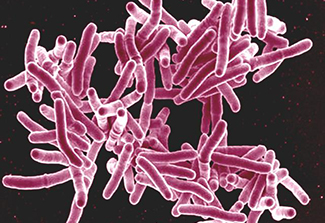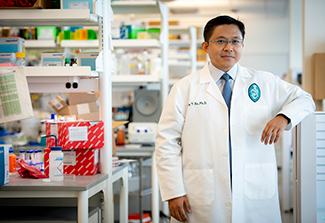Smartphone-sized system uses CRISPR-based reagents to rapidly diagnose TB
May/June 2025 | Volume 24 Number 3
 Photo courtesy of NIAID
Bacteria that causes TB
Photo courtesy of NIAID
Bacteria that causes TB
An estimated 10 million people, including more than a million children, develop tuberculosis each year. Roughly half of all infected children go undiagnosed or unreported. Several reasons contribute to the high number of untested and untreated patients.
To test for tuberculosis (TB), the World Health Organization recommends either an interferon-gamma release assay (IGRA, a type of blood test) or a tuberculin skin test (TST), which requires a shallow injection beneath the skin. IGRA requires specialized facilities and trained staff, consequently the skin test is more commonly used in low resource settings. Yet, there’s a major drawback to the skin test; results are read two to three days later, so a patient must return to a healthcare provider or clinic, which in low resource settings may be far from home and difficult to access.
One other reason for the high numbers of undiagnosed children is “the IGRA and TST can only confirm that a patient has been infected with
Mtb, they cannot distinguish latent TB infection from active TB,” says Dr. Tony Hu, a distinguished professor of biochemistry and molecular biology, biomedical engineering, and microbiology at Tulane University. (Mtb or
mycobacterium tuberculosis is a species of bacteria that causes tuberculosis; a latent TB infection means a person lacks symptoms but has a small number of living, inactive germs in their body, while active TB means a person has both symptoms and many active germs in their body.)
High numbers of undiagnosed cases, then, are also a result of the current, limited active TB testing capabilities, which require “expensive, bulky equipment not suitable for point-of-care testing,” explains Hu.
 Photo courtesy of Tulane University
Dr. Tony Hu
Photo courtesy of Tulane University
Dr. Tony Hu
TB testing innovation
To remedy this, Hu and his team developed a new assay that specifically and quickly tests for active disease, diagnosing patients with either symptomatic or asymptomatic TB. Its reagents, based on the CRISPR DNA-editing technology, can identify
Mtb DNA in either sputum (mucus produced in the lungs and airways and coughed up), blood or saliva samples.
Use of blood and saliva is key: Children (and many people living with HIV) often cannot produce sputum, so saliva or blood is much easier to obtain. The smartphone-sized, battery-powered device is also economical, costing less than $800, with each assay totaling less than $3. Most importantly, it delivers accurate TB diagnoses in under an hour.
For all these reasons, Hu and his team are hopeful that their TB testing device will contribute to improved rates of diagnosis across the globe. Their research, published in
Science Translational Medicine, was supported by the
National Institute of Allergy and Infectious Diseases, the
National Institute of Neurological Disorders and Stroke, the
Eunice Kennedy Shriver National Institute of Child Health and Human Development and other funders.
Accuracy & availability
A test’s accuracy is determined by its sensitivity and specificity. Sensitivity refers to a diagnostic test’s ability to correctly identify patients with a disease, while specificity refers to a test’s ability to identify people without the disease.
Using saliva samples from 15 TB positive and 15 TB negative patients, the test (known as LIT-TB) achieved 73% sensitivity and 100% specificity. Overall, sputum testing had perfect sensitivity (100%) and 90% specificity. “LIT-TB clinical testing had slightly lower sensitivity using saliva and blood compared to sputum, but both non-sputum sample types displayed higher specificity than sputum,” explained Hu. “The device performed similarly in saliva, blood, and sputum when combining sensitivity and specificity metrics.” The team is working to improve sensitivity related to saliva and blood samples, given how important these options are when testing children and patients living with HIV.
Though the new test is not yet commercially available, “Tulane is negotiating with some industry partners to manufacture and bring the LIT-TB test to market, including
IntelliGenome,” says Hu. IntelliGenome, located in Houston, TX, recently received a Breakthrough Device Designation from the U.S. Food and Drug Administration for a bench-top version of a CRISPR-TB blood test.
“Our point-of-care device is the next step in addressing TB diagnostic needs,” says Hu. Going forward, his team is pursuing additional CRISPR-based assays and clinical tools.
More information
Updated June 2, 2025
To view Adobe PDF files,
download current, free accessible plug-ins from Adobe's website.